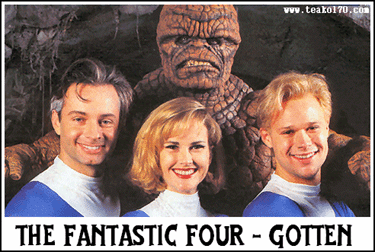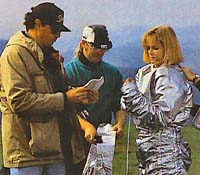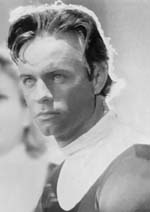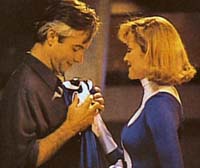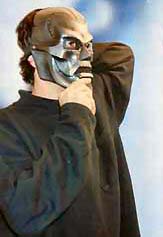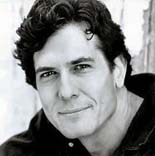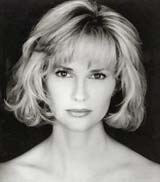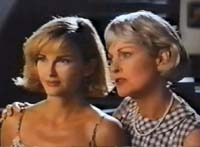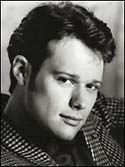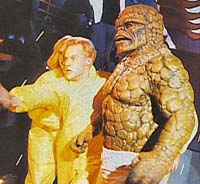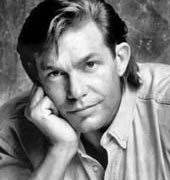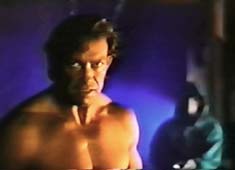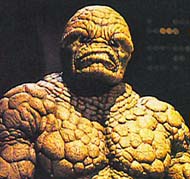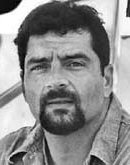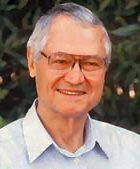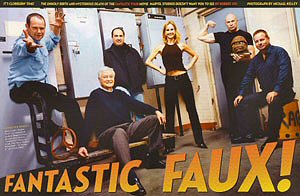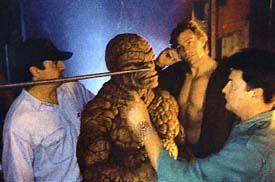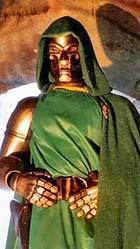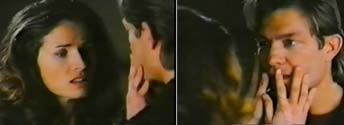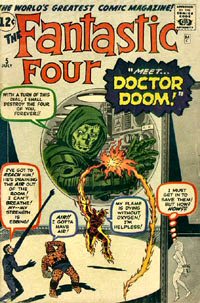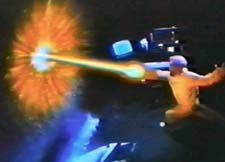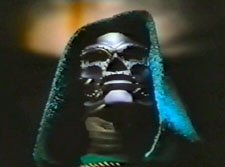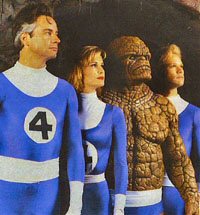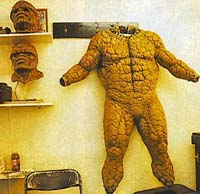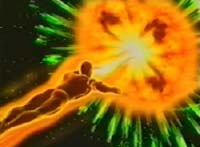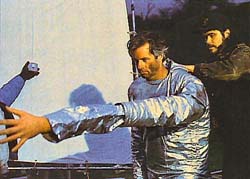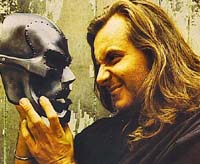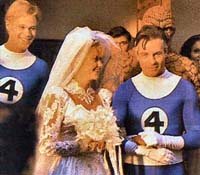...It's Clobberin' Time?When Benjamin Grimm first uttered these words, it was his intent to pummel whatever evil menace that threatened humanity yet not even the all-knowing Watcher would've foreseen that such a battle cry would someday be meant for Ben and his "fantastic" teammates.
No, this calamitous blow would not come within the pages of their long running Marvel publication. This blow was dealt by Hollywood where "The World's Greatest Comic Magazine" had its first excursion into the magical world of cinema in 1994 -- only to be abandoned by the studio that created it. Eleven years later, the DVD release of the new Fantastic Four film (12-06-05), will allow many to finally possess a piece of the Fab 4, but its their first adventure that remains to be unseen by the masses.
Thanks to the resourcefulness of some die-hard fans, copies of the FF's first film have made the rounds of comic book conventions and on-line sites, like eBay, over the past decade but it has been far from a glorious existence. The movie is a videotape trapped in a netherworld of agonizing N-th generation bootlegs. A world so mortifying that not even Stan or Jack could have fabricated.
As Ben would've said... "Whatta revoltin' development!"
THE STORY BEHIND THE STORYFlashback to 1992. Neue Constantin Films of Germany had owned the film rights to the FF property for several years but these rights were to expire on December 31st and revert back to Marvel. Neue Constantin wished to renew their option but were denied by Marvel who, up to this time, had yet to experience any success with adapting their characters to the big screen. There was the ill-fated Punisher film with Dolph Lundgren and the direct-to-video Captain America production. Conan the Barbarian (starring Arnold Schwarzenegger in the role that made him a household name) was considered the only bright star in Marvel's stable. Times were changing though and it appeared Marvel was intent on regaining control of their flagship title.
In order for Neue Constantin to retain their option, they would need to rush into production before year's end. They entered into a partnership with Concorde Pictures in the Autumn of '92 and under the helm of B-movie king, Roger Corman, a paltry budget was raised. Principal shooting of the first Fantastic Four movie commenced on December 28, 1992.
Assigned to the directorial reins was Oley Sassone. Sassone had cut his teeth in the biz by directing over 100 videos and was no stranger in working with limited budgets and constrained schedules. He was aware of the comic genre's failure in Hollywood and was intent on not letting the fans of the FF down.
Sassone (left) with Rebecca Staab"I went back and read every single issue of The Fantastic Four Marvel Masterworks series before I went to bed, just to re familiarize myself with these characters," said Sassone who believed big-budgeted films like Batman failed to meet people's expectations because they did not feature enough character development. "You've got to touch people on an emotional level, whether its The Fantastic Four or On The Waterfront."
Despite the meager funding his film received, Sassone seemed to take the Francis Ford Coppola approach to filmmaking who once stated: "...my attitude towards money is I don't have very much of it but if I use it in a very audacious way, it multiples itself. If you have a thousand dollars but willing to use it, not caring of risk, you can make it feel like ten thousand." Indeed such a philosophy seemed to work because Sassone's cast and crew poured themselves into the 25-day shoot, working upwards of twenty hours a day, transforming a modest motion picture into something much grander.
"Having the opportunity to bring these mythological characters to life is great," reflected Sassone. "Stan and Marvel have already made them a legend and it was like being handed gold."
But would Sassone's optimism last? Once principal photography wrapped in late January 1993, it was still a long path before the film made its way to "opening night." A night that Sassone and company would unknowingly never experience.
THE CAST
Alex Hyde-White Alex Hyde-White was born in London in 1959 but raised in California. His father was veteran actor Wilfrid Hyde-White who is probably best known for his role as Colonel Pickering in My Fair Lady. Alex Hyde-White attended Georgetown University before starting his acting career at Universal Studios as one of the last "contract players." He appeared in a variety of television projects from the late 70s into the 90s. Appearances included such shows as "Buck Rogers," "Battlestar: Galactica," "Newhart," "Hill Street Blues," and "Murder, She Wrote." Feature film roles included The Toy and Isitar though he is best recognized as David Morse, the polo-playing industrialist grandson of Ralph Bellamy, in 1990's blockbuster Pretty Woman featuring Julia Roberts. Hyde-White had also appeared in 1989's Indiana Jones and the Last Crusade as Young Henry (though these scenes were deleted from the final print). In 1992, he was offered the role of Dr. Reed Richards a.k.a. Mr. Fantastic.
"The great thing about Reed Richards is that he's a mildly psychotic and dysfunctional superhero and a human being as well," stated Hyde-White who admits he hadn't read the Fantastic Four comics as a youngster but was a fan of the Hanna-Barbera cartoons of the late 60s.
Reed Richards & Susan Storm "To play the deepest thinker in the Marvel Universe is quite an honor," he comments though the role also posed some physical challenges for the thespian who dyed his temples gray for the part.
"The way the arm extends is a real trick. When I get ready to throw a punch to Dr. Doom, I have the plaster cast on my shoulder that is rigged to a hydraulic," he explains. "My real arm is at my side, sort of gripped back, and controls this arm that extends and holds it in place. So after six or 12 takes of this, its pretty heavy and really cinched tight. It was much more of an effort for Richards to throw a punch than I think Stan Lee intended."
Hyde-White has continued his career in both film and television since the FF. His latest roles include the Warner Bros. Civil War epic Gods and Generals, playing Union Commander Ambrose Burnside, and Steven Spielberg's Catch Me If You Can. If you're a fan of daytime soaps, he played Charles Cahill III in "Days Of Our Lives." Hyde-White is also an avid golfer and has raised over $200,000 for various charities. He can currently be seen in two 2005 productions: A&E's "See Arnold Run" (a bio of Arnold Schwarzenegger from his early days as a body builder up until his successful campaign for governor of California) and as Gadget Husband in Complete Guide to Guys.
Culp as Dr. Doom Joseph Culp (Victor Von Doom) is another actor who has followed in his father's footsteps; veteran actor Robert Culp. The elder Culp is best recalled as agent Bill Maxwell in the 80s TV series "The Greatest American Hero." The younger Culp even appeared in an episode of the superhero spoof series in 1983.
Born in Los Angeles in 1963, Joseph Culp began acting in school plays at the age of nine and went on to train in both New York and Los Angeles under numerous instructors. He had appeared on both the large and small screen and on stage when he was offered the role of the nefarious antagonist of the FF; Victor Von Doom. He approached the role with a fervent understanding of the character:
"Dr. Doom is a very operatic character - a glorious tyrant king. For me, Doom was an operatic dip into my own latent sadomasochistic tendencies." He continues, "Doom is a narcissist to the extreme. I believe he is completely scarred and mutilated. Being such a brilliant scientist, he could certainly reconstruct his face but he chose to keep his scars as a living testament to his vengeance on the world and specifically, Richards."
If you wonder if Culp ever contemplated "what's my motivation?" he is fairly clear in his analysis of the tormented genius who, he believes, has a love/hate relationship with his long-standing rival.
Joseph Culp "Doom's inner sorrow and frustration - a kind of unbridled psychotic rage - propels him to do the things he does. I think deep down he loves Richards ... the person you love is the one you hate the most. Remember, Doom is all that we wish to be and all that we cannot face. From the depths of our fear he is the towering Freudian id. He's a raging ego and a wounded lover."
If that wasn't motivation enough, Culp might have also been inspired by the fact he was incarcerated in a iron suit for most of the film which dug into his left leg, leaving him with a scar or two of his own.
Today, Culp continues to work on both coasts. He was featured in HBO's "Full Eclipse," the noir thriller Innocents, Ron Howard's Apollo 13, and Mario Van Peebles' Baadasssss. On stage, he has performed in multiple productions and received a Drama Logue award for his performance as a rebel Irish coal miner in Jason Miller's "Nobody Hears a Broken Drum." Culp is also founder of the Los Angeles-based "Walking Theater Group/Workshop" where he performs as actor, writer and director.
Rebecca Staab Rebecca Staab (Sue Storm) was born in Hays, Kansas in 1961. From a very early age, she knew she wanted to be a dancer or an actress and was a huge fan of the 70s TV series, "Little House on the Prairie."
"My best friend and I became fanatics," she says with a laugh. "I was like, Oh, my God, I have to be Mary. That was my calling." Still, Staab kept that dream on the back burner. "I did theater in high school but I was a real academic," she explains. "It wasn't logical to say, Oh, I'm going to be an actor. I was a straight-A student in high school and in college. My major was speech with journalism."
At the age of 20, Staab was crowned Miss Nebraska and was a runner-up in the Miss USA Pageant of 1980. She then pursued a career in modeling for the Ford Modeling Agency and spent two years in Paris.
In 1985, Staab landed her first acting gig on the (now-canceled) soap opera, "Loving" and then moved to the daytime drama, "Guiding Light," where she played Jesse Lynn Matthews from 1985-1987. Staab also appeared on the big screen in such films as Love Potion No. 9 starring Sandra Bullock and The Substitute 3. In 1992, she took on the role of Marvel's first lady, Susan Storm/ Susan Richards.
Sue Storm and Mom "When I walked into the audition, they had pictures on the wall of Susan Storm and I thought, This is good. She looks just like me." When asked if she would like to be a superhero in real life, she responded, "I think it would be great! But it depends on what power it is ... if I really had the power to become invisible, I would do it in a minute."
Those powers of invisibility would certainly have come in handy for Staab. The skintight spandex suit she wore left little to the imagination and distracted many of the production crew who hoped to sneak peeks of the not-so Invisible Girl.
Since the FF, Staab has continued to guest star on various television shows. Appearances include: "Beverly Hills, 90210," "Cheers," "Home Improvement," "The Drew Carey Show," "Martial Law," and "Dharma & Greg." In October of 2002, she made her first appearance as Elizabeth Barrington on the ABC soap, "Port Charles" - a spin-off of "General Hospital." The soap was canceled during the summer of 2003 but Staab continues to pursue future roles on both the small and big screen. Her most recent TV appearances include "Nip/Tuck," "Navy NCIS," and an October 2005 episode of "CSI: NY."
Jay Underwood Jay Underwood (Johnny Storm) was the youngest of the five leads cast but his professional career quickly took off as a teen actor in the mid 80s. The Minneapolis native's best known role was his sophomore effort in which he portrayed the autistic Eric Gibb in The Boy Who Could Fly. He would also star with Alan Thicke in a trilogy of films, Not Quite Human, as the teen-android Chip Carson and appeared in the 1989 comedy, Uncle Buck.
In the Autumn of 1992, Underwood was cast as the fiery-tempered Human Torch though playing the role was a bit of a stretch for the then 24-year-old.
"I'm the complete opposite of the Torch," he comments. "He's got a really quick temper and that's not really me. I think I would be a bit more passive. I like Aquaman because he swims around and gets the fish to do the work. That's more my speed."
Johnny & The Thing in action Not a natural blonde, Underwood had a severe reaction to the dying process in which his scalp blistered. This was a rather tame setback considering the potential for injury from the pyrotechnics his character was involved with. "You've got to be careful … no matter how safe it seems, you've always got to be on top of things." Indeed, Underwood is no stranger to portraying characters with unusual talents.
"When I did The Boy Who Could Fly, the Disney Channel asked me to tape a disclaimer telling kids that its just a movie and don't try to fly," he recalls. "In fact, I heard a little kid tried to fly and jumped out his window. I think it's more the responsibility of the parents than the filmmakers to explain that this is fantasy." Regarding the character of the Torch and the possibility of someone attempting to mimic his on-screen feats, he puts it very frankly: "I do not recommend playing with fire."
Since the FF, Underwood has been involved with over twenty film and television projects. He's made several guest appearances on a variety of TV shows such as: "ER," "The X-Files" and "Star Trek: Voyager." Probably his biggest role was that of the late singer Sonny Bono for And the Beat Goes On: The Sonny and Cher Story in 1999. More recently, he was seen in 2004's Win a Date with Tad Hamilton! and the 2005 TV film, Annie's Point. These days, Underwood has left the Hollywood spotlight for a new calling as a Baptist pastor in northern California.
Michael Bailey Smith Michael Bailey Smith (Ben Grimm) led an incredibly diverse life before embarking on his Hollywood career. Born into a military family, Smith traveled the globe as a youngster, attending high school in Tehran prior to the Iranian Revolution of 1979. After high school, he joined the US Army and became a paratrooper with the 82nd Airborne. He later attended Eastern Michigan and played football where he was scouted by the Dallas Cowboys. Unfortunately, a senior-year knee injury ended any chances of playing in the NFL.
In 1989, he tagged along with a friend who was auditioning for Nightmare on Elm Street 5. The casting director urged the 6' 4" body-building Smith to tryout for the muscle-bound dream form of Freddy Kreuger.
"Director Stephen Hopkins asked me if I could laugh like Freddy," he recalls. "I said sure and proceeded to deliver this hideous laugh. I was hired on the spot." Thus a career was born and a few years later, the Fantastic Four came a knocking.
Smith as Ben Grimm "I was thrilled that I got this part. For the first time, I got to play a character that wasn't a bad buy. I remember Stan Lee coming to the set and he said if he was to make Ben Grimm as a real person, it would be me." Smith though didn't have the opportunity to play Ben's alter ego, The Thing, because another actor (Carl Ciarfalio) had already been cast in that role.
"I personally took it upon myself that if I couldn't be in the suit, then I wanted to have as much input as possible. I wanted there to be continuity, so that the mannerisms are basically what I would do." Smith handled the situation (which could have bruised some actors' egos) with a high level of professionalism and worked alongside Ciarfalio as a team. "Carl is not only a great stunt man but a good actor as well. A real professional and he put so much into it," Smith responds.
Following the Fantastic Four, Smith continued to expand his resume in working on multiple productions. He has made guest appearances on a variety of TV shows though he is best noted for his role as the demon Belthazor on the hit series "Charmed." In film, his recent appearances include In Hell as a Russian prisoner who is pitted against Jean-Claude Van Damme and as the character called "Creepy" in the mega-hit MIB 2. His latest effort has taken him to Morocco for the remake of Wes Craven's The Hills Have Eyes - slated for a 2006 release. For more on Smith, visit his personal website which includes video clips, still images, a ton of entertaining tales in-his-own-words, and more.
The Ever-lovin' Thing Carl Ciarfalio played The Thing (in costume). Just like David Prowse never gets enough credit for playing Darth Vader in the Star Wars trilogy, Ciarfalio deserves to be recognized for his participation in this film.
"They built the whole Thing custom for me. They had to cast my entire body - it was quite an experience," Ciarfalio recalls. "I wasn't familiar with the Fantastic Four so this was an all new adventure." Ciarfalio's stunt background certainly helped maintain a level of continuity for the character. "I've been doing stunts for so long that when I double an actor, I have to move like him... walk like him."
A twenty-five-year veteran of film, Ciarfalio has enjoyed a prolific career and his resume reads like a "Hollywood Who's Who" having worked for such industry heavyweights like Martin Scorsese, Ron Howard, Steven Soderbergh, Tom Cruise and Clint Eastwood. He has appeared in bit parts in a slew of Hollywood hits from Casino, Con Air, and Fight Club.
Carl Ciarfalio As mentioned earlier, Ciarfalio is an accomplished stunt person and member of the Stuntmen's Association of Motion Pictures since 1985; president from 1992-1996. Since the FF, he has worked in over thirty productions. Credits include: Batman & Robin, Artificial Intelligence: A.I., Daredevil, MIB II, and Bruce Almighty.
Other cast members include: Ian Trigger as The Jeweler - a character that is not in any FF comic. The British born actor had a handful of acting gigs in the 60s and 70s but anything since 1994 seems to be unknown. Kat Green played Ben's love-interest, the blind sculptress Alicia Masters, who first appeared in the FF comic in Nov. '62 (Issue # 8). Mercedes McNab played the role of Young Susan Storm. Before the FF, she gained prominence for her role as the girl scout in The Addams Family and as Amanda in Addams Family Values. More recently, she is best known for playing 'Harmony' on the hit television series "Buffy, the Vampire Slayer" and its spin-off "Angel." Phillip Van Dyke was only eight when he played the role of Young Johnny Storm. Since then, he has enjoyed a steady string of jobs, working in both features and television, and as a voice-over artist.
Annie Gagen (Mrs. Storm) had appeared in a variety of TV shows during the 80s ("Scarecrow and Mrs. King," "Falcon Crest," "Murder, She Wrote," and "Highway to Heaven" - to name a few). More recently, she has been seen in "Yes, Dear" and "JAG." In the FF movie, it was her line that initially dubbed the foursome, the "Fantastic" Four:
"I hardly remember much of it," she comments in a recent email. "My daughter was a baby and I was only willing to take short term jobs. I know I was on the phone to home a lot checking on her. I do remember the costumes, hair and make-up which I thought were terrific. ... and I have absolutely not one picture from it! The casting directors were dolls and the young cast extremely attractive. It was exciting auditioning at Roger Corman's company (the legend) and working on a film for his company.
I felt bad when I read all the back story about how they had no intention of releasing it. Those young actors and Alex Hyde-White seemed very positive and excited about the success and future of it."
She continues, "I ran into Alex later as his son was at my daughter's pre-school but we never spoke of the Fantastic Four. I felt like that was a very sad episode having never even finished it and it sitting on a shelf somewhere. Someday I hope to see it, if for nothing else, out of curiosity." (note: A copy of the film has been sent to Annie. Hope she enjoys it.)
THE AFTERMATHLike an urban myth, the story of what happened to this film after shooting wrapped seems to deviate from source to source. Stories in the trades, newspapers, cyberspace - they all have a story to tell. The difficult part is weeding out rumors from reality. What follows are several accounts by individuals involved in the production: Roger Corman, Bernd Eichinger, Michael Bailey Smith, Joseph Culp and Oley Sassone.
Roger Corman Roger Corman: "Bernd Eichinger, the German producer, had the rights to The Fantastic Four and he was going to make it on about a $40 million budget but couldn't raise the money and his option was going to run out in three months. If he didn't start the picture, he would lose his option. So he came to me and said, "I didn't get my $40 million. How much can you cut this budget to and let's make it together at your studio." So we figured out a budget and we cut it from $40 million to $1.4 million and made it."
Indeed, Eichinger picked the right man for the job as Corman was a filmmaker renowned for his thrift. A director who would often shoot two movies simultaneously and in break-neck speeds. He once shot an entire feature, Little Shop of Horrors, in under three days - on a bet.
"We were going to distribute it but he had a clause in his contract that he could buy me out at a rather substantial profit for me anytime up to ninety days after the picture was completed. During that time he raised his $40 million. He bought the picture out from me and he's making it for Fox.
I was reasonably happy because I made a profit, but I didn't get a chance to distribute the film because I wanted to see how that type of comic book movie fared. At that time, we were making pictures at $500K to $1 million. For $1.4 million I had what I felt was a bigger film and wanted to see how it performed. I never got the chance to try the experiment."
Fantastic Reunion 2005 The interesting point here is Eichinger was unable to secure the capital needed ($40M) to produce a large-scale production yet after the film was made, he somehow managed to acquire the funding. This special clause Corman comments on makes one begin to wonder if this film was sabotaged from the get-go. Indeed if it was, no one from the cast or crew, including Corman, seemed to be in-the-loop. In a recent LA Magazine article titled "Fantastic Faux," Eichinger rejects the rumored statement that the film was never intended to be released.
"No, that's not true," comments Eichinger. "It was definitely not our intention to make a B movie, that's for sure, but when the movie was there, we wanted to release it."
He then continues, "...Avi (Arad) calls me up and says, 'Listen, I think what you did was great. It shows your enthusiasm for the movie and the property. I understand that you have invested so-and-so much and Roger has invested so-and-so much. Let's do a deal.' Because he really didn't like the idea that a small movie was coming out and maybe ruining the franchise. So he says to me that he wants to give me back the money that we spent on the movie and that we should not release it."
Arad, the head honcho at Marvel and the man responsible for many of their recent box-office hits acknowledged the sale at a 2003 press junket for the first Spider-Man film. He stated he purchased the film for a few million dollars and ordered all prints destroyed. When Arad was contacted by LA Magazine to set up an interview about the original FF film, his publicist first said that a meeting might be arranged in a few weeks. Weeks passed but the interview never materialized. Finally his publicist reversed course stating an interview wouldn't occur as Arad didn't wish to talk about that old movie - only the new one. Stan Lee, on the other hand, seemed enthusiastic in partaking in a photo shoot with the original cast. But again, like Arad, Lee reconsidered stating he'd rather not be associated, in any way, with the old FF film.
Its almost as if the original FF film is the bastard child of the Marvel Universe and anyone associated with the 2005 movie doesn't want to soil their hands by even acknowledging the existence of the first film. While the original cast members don't seem to have held any grudges, Jay Underwood described as what happened as "the seedy, cheesy side of Hollywood." The one comment that best sums it up though was made by Rebecca Staab who, while driving in her car last year, overheard a radio announcement for "the biggest movie of next summer."
"This movie just got bigger and bigger and I'm like, 'What movie are they talking about?,' she recalls. Another teaser followed and then, another. "Finally they say Fantastic Four. That's when it feels like a dagger in your gut. I'm like 'Aaaaah! No, no. That's our movie!'"
On his site, Michael Bailey Smith has a more personal account of the project and how it all unfolded....Michael Bailey Smith: "Before the movie, I really didn't read any comic books. When I got into lifting weights, I enjoyed anything that was big and muscular. I loved the Hulk," Smith admits. "However, when I got the part, I read a lot. Plus, going to conventions and comic book stores, I became a fan of the comics and fans who read them. It was incredible to see the faces of the people when you met them and they knew you played Ben Grimm. Pretty awesome. We had such great hopes for this film. This was going to be the film that was going to give a boost to our careers. Take us to the next level … But it never happened. The film was shelved."
"...when I first got the part I thought I was not only going to play Ben Grimm but The Thing also. But production told me that they had hired a stunt man to play The Thing, mainly because it took several months of pre-production getting the suit ready. Carl Ciarfalio played The Thing and he was willing to work with me to make sure that continuity between the Ben Grimm and The Thing remained the same."
Ciarfalio (costume) and Smith (rear) collaborate Smith confesses it was a joy to play Grimm because he basically got to play himself.
"I got to act like a little kid, fall in love and experience the horrible change into The Thing. There was a full range of emotions I experienced with this character. When we finished the film, the cast knew we had something. We knew that this could turn into a little gem."
Smith believes this first became apparent during the Los Angeles Comic Book Convention at the Shrine Auditorium.
"The production company, Concorde Pictures (Roger Corman), played a trailer at the convention to see the response. There must have been 500 people waiting for hours to see the preview. It was awesome! When the preview finished, we all heard a thunderous cheer from the audience. Right then, we knew we had something. We asked Concorde Pictures what promotion they were going to do. They said that they couldn't do much more due to budget constraints. So that's when Alex Hyde-White and I went to work. We hired a publicist and began to work on promoting the film. The only help we got from Concorde Pictures was production shots of the cast to autograph for the fans."
This limited assistance didn't deter Smith and Hyde-White who, with the help of their publicist, promoted the film by visiting multiple comic book conventions and stores throughout the country
Dr. Doom "We showed the preview, talked about the characters, went to children's hospitals ... did everything we possibly could to promote this film. It was fantastic seeing the look on people's faces, their excitement and enthusiasm; especially the little kids. We took a little low budget film that had no chance of really doing anything and generated enough publicity, enough heat that people throughout the country started talking about it."
Unfortunately, while their on-screen counterparts possessed extraordinary powers, they were about to hit a brick wall that not even Aunt Petunia's favorite nephew could topple.
"In mid-January (1994), we had it all set up. We were going to have the premiere at the Mall of America in Minneapolis. We had the Ronald McDonald House and Children's Miracle Network tied into the premiere. We had local and national TV and newspapers tied in. With our own money we did all of this. But, one week before Christmas, I got a call from our publicist. The film had been shelved and to stop all efforts in promoting the film. I was devastated. All that work, all of our hopes and dreams for this film, were gone. At the time, we didn't know why. All we knew was that no one was going to see this wonderful little movie."
What Smith and Hyde-White were to find out was mentioned earlier in that if Neue Constantin hadn't started production before the end of 1993, they would lose all rights to the property.
"We started filming in December, which at the time I did think was a little strange because most of Hollywood slows down during this period. With Neue Constantin retaining the rights, it was their chance to continue shopping it around to the big studios. Not the finished movie of course, just the rights. They found a buyer in 20th Century Fox Studios. So, that was it.
When I look back at what happened, there is still a little sadness but it was a great experience meeting and touching the lives of so many people that had a common bond with the Fantastic Four. Maybe the visual effects weren't the greatest but you know what, the story was great, the characters were great and all of the actors put 100% into the making this film very special."
Love at first touch: Alicia Masters and Ben Grimm Smith also learned a very grim fact about the industry he had become a part of. A realization he embraces with every project he now finds himself in.
"This is Show-BUSINESS, not Show-FRIENDS. It's all about business … all about making money. Like it or not, that's the way it is. From this point on in my career, my perspective on the whole industry changed. Whenever I've finished a film or a TV show, I basically just let it go. I've done my job as an actor and that's all the control I have. But you know what, if I had to do it all over again, I would. Call me crazy, but I would."
Joseph Culp was certainly intrigued about playing one of the most notorious comic book villains - despite the size and constraints of the production. While it's the tendency for many actors to experience varied levels of anxiety when auditioning for a role, Culp quickly seized the persona of the character who had little to fear.The webmaster had the opportunity to interview the "man-behind-the-mask" in early October 2005:
Joseph Culp: "It was raining the day of the audition and so I wore a full-length Australian Outback oilskin duster. It was very grand and served me as my "suit of armor." I played the young Victor scenes with more softness and vulnerability, as someone who really wanted a friendship with Reed and had a hidden passionate motive to capture Colossus (these elements were not written into the script, so I felt obligated to create them as emotional subtext). As the transformed Dr. Doom, I embraced the imperious, commanding style of the comic. I'm sure other actors were considered but I think I showed I was not going to hold back and willing to go all the way. I had an idea or two about the character, which was valuable for filmmakers under the gun, and probably for other unknown karmic reasons, Doom was mine."
Otto Von Doom is a very tragic character - something one might see in a play by Shakespeare. Considering your background in the theater, have you found one character of literature that is synonymous with Doom?
Fantastic Four # 5 "Doom is definitely an archetypal figure. By that I mean there is something about his persona and image that comes from the collective unconscious that has appeared many times throughout mythology and literature: The Tyrant, the Mad Genius, the Human/Machine that is the dubious legacy of the industrial revolution, and another incarnation of the Shadow side of Christianity - the Devil that hungers for ultimate power and domination. We can also say he is the uncontrolled "Id" or the part of human psyche that expresses instinctual desire, often repressed and anti-social, usually aggressive and sexual in nature. So this character is going to show up again and again as bloodthirsty Herod, the driven, strangely narcissistic Richard III, and the brilliant, tortured Phantom of the Opera.
Let's face it, isn't Doom the original Darth Vader a.k.a. "Dark Father" - the gifted one, traumatized in youth, corrupted and mutilated by power and becoming obsessed with power and half-human? I thought about a lot of these connections for Doom, (I had worked on Shakespeare's Richard III, a disfigured royal whose inner sorrow and rage propel him to kill for the throne) but mostly tried to work intuitively and use my imagination to bring to life what I saw in the comic books."
Collectively speaking, do you feel that your representation of Doom was a success? Would you have preferred to done anything different?
"True to the spirit of Doom (and the narcissistic actor playing him) I just wish the story had been more about ME! (haha) Seriously folks... The script for this film had to cover a lot of ground quickly and there was no real backstory or clear motivation for Victor to do what he does. I tried to insert as many nuances or references as I could to paint a full portrait. How to show a crazed mad genius and tragic egoist who we enjoy watching without just clunking around in a plastic suit on a cheap Corman soundstage? One answer: Go all the way and hope for the best.
It's well known to hardcore fans that Doom's mother was a gypsy, killed when Victor was a boy, so his obsession with power/magic/mystical arts was embedded with his longing for the lost mother, attaining power and avenging her death. He has royal blood, or believes he does, and is living in exile. I imagined that capturing Colossus was even a plan to use it's power to communicate with the dead mother and to claim his rightful place on the throne of Latveria. I made attempts to convey his complex character through little bits of behavior. So, kissing his mother's medallion in the lab scene, examining Dr. Hauptman using Chinese medicine technique, sexualizing hostage Alicia, the envy/hate with Reed, and the striking of grand poses and gestures, even a sense of his own auto-eroticism, were colors I hoped would complete a picture.
The one quality that I thought was sometimes missing from the comic was Doom's sense of humor or irony. Something to temper his love of melodrama and flair for the bombastic. It was in the script to give him a mad laugh, and definitely encouraged by the director, so I tried to come from his rage and pain and let him go for it. A self-proclaimed king must laugh at his absurd adversaries to keep his persona intact. Though there may be a desperate crack of longing somewhere underneath.
Flame On! was first used in FF # 2 The constraints of low-budget, serviceable script, time and production value can only support an actor's choices so far. Would this version of Doom be as monumental as it should be? Not bloody likely. But I feel under the extraordinary circumstances of trying to do this kind of film, my Doom has some fine, even fun and interesting moments that honors the comic book version in many ways. And if it doesn't live up to everyone's expectations, fans should see it for what it was, i.e. a pretty good try and not take it too seriously.
The ONE THING I wish would have been done differently was Doom's SOUND! The production sound for many of my lines was so horribly garbled inside the mask, that it's almost unintelligible at times. So much nuance was lost. And I was compensating to begin with because of the mask. The director, to his credit, wanted to keep as much of my actual performance as possible, so they only had me replace certain sections in post. But you can hear the vast difference in clarity. What was re-recorded sounds clean and what was live sounds muffled and is just bad sound. I absolutely hated this and it broke my heart. I wished we would have gone back and replaced every single line and created more of a real effect for Doom's "amplified" voice, which it certainly should've been. So if Avi Arad and Marvel and Fox ever get smart and decide to release this film as a special DVD bonus, my wish is that they'll let me re-record Doom's dialogue. I'd do it for free. But that's in another universe where people give a shit about stuff like that. (Maniacal evil laugh...hahahahaha...)."
As it turns out, Doom's technical difficulties would become pale in comparison to the bomb that was dropped shortly before Christmas 1993.
Doom, Ruler of Latveria "Sassone called me to tell me the film was shelved. I was pretty stunned because we had been doing press junkets at comic conventions and magazine spreads and it looked like we'd get a little release. And who knows, the film was a pretty heartfelt try and probably kids and less discerning fans would dig it. I always thought it would have made a great pilot for a TV series; better than Power Rangers by far. I think the rest of the cast were pretty disappointed, especially since they were the Four, and it might have given us all a little heat. But I have to say I wasn't that upset about it. It was what it was and it was a gamble at best.
My life as an actor is a gamble everyday with movies, TV, theater, who knows what will "hit" and "define" me? You just keep going and challenge yourself and try to get better at the craft. I felt proud that I got to be the first Dr. Doom, and nobody can take that away, (I have two pages in the big Marvel coffee table book) and my 11-year-old son has grown up watching the tape, mimicking my lines and laughter, applying them to some serious toy-playing with a Doom figure, and knowing his old man was the O.G."
Not only was Culp the first Dr. Doom, he might also be the first to show us that Doom could be quite the ladies man - well, at least off-camera.
"The one moment during the shoot I remember best was suiting up in my dressing room and walking out to the soundstage to shoot a scene in the Jeweler's lair. Rebecca Staab was standing there in blue spandex and I grabbed her for everyone's benefit and gave her a big kiss at which everyone cheered. I then strode down a hallway - green cape flying - where crew members were lined up chanting "DOOM! DOOM! DOOM!" I was the Man! And everyone empowered me to be HIM! Here we were, a rag-tag team of artists, technicians and misfit comic fans, making a little movie with heart and having a good time. It was a cool moment."
Finally, Culp comments on the new film.
FF Publicity Photo "I haven't seen the new FF film only because I've been pretty busy. But I saw the trailer and it looks like great FX and a lot of fun. My son went to see it and liked it but insists that I am the real Doctor Doom. He said, "The new Doom is just kind of crazy." (He's a good loyal son, after all! ) I'm sure I'll see it on DVD. If they do a sequel, they should put the old cast in as some kind of fun cameo, just for the fans out there who know about our film. One fan wrote me an email that said low-budget and primitive FX aside, he thought my Doom knew what he wanted (to kill Reed and drain them of their power) whereas the new one was unclear. Hey, it usually comes down to the script - which took Fox only 12 years to come up with!"
You can catch Culp in his latest effort, Cyxork 7 (a wacky comedy about making a low-budget sci-fi, incidentally), which premiered this October at the FAIF Film Festival in Hollywood and the DNA Film Fest in Toronto. Currently, he's finishing post on The Artificial Feast and will soon begin shooting, in both Mexico and Los Angeles, a new film that he wrote in which he'll direct and star in as well.
"As Doom would say...'Here's to the future, my friend!'"
Turning the microphone now over to the "man-behind-the-camera," director Oley Sassone provides a unique opportunity for a rare, behind-the-scenes look at the making of this film and those responsible.Terrence Brady: First question. Comic book films already have a built-in audience. How did you approach your film to appease this crowd and, on the same hand, engage a general audience who might not be aware of these characters?
Oley Sassone: "I first of all want to say that the script was well written, based on very well defined characters created by Stan Lee. After that, the approach was dictated by the budget. I knew that we couldn't do a big special effects movie, so focus was on the characters and their relationship to one another. I kept trying to just tell a good story and there were a couple of universal themes in the script: good vs. evil, betrayal, loyalty, The Thing's internal struggle with dealing with being "different," ugly, an oddity. How many people can identify with that?
When he feels unloved and abandoned by his comrades, he tries to lose himself in the underbelly of the city. And no matter how hard he tries to make people see him through his eyes, he's still a scary, freak of nature. I thought of The Elephant Man, when we were shooting, in that brilliant sequence when he's being chased until cornered in the public toilet and decries, "I am not an animal!!" Ben Grimm does eventually find solace among all of the misfits and dregs of society.
Johnny Storm becomes heroic and saves New York City. Reed Richards saves Sue Storm and together they try to bring Dr. Doom to justice. Even in the end, Reed tries to save Victor Von Doom as he hangs on the edge of his castle wall; a caring super hero who did not lose his sense of humanity. So I think to engage an audience, no matter if it's a comic book audience or otherwise, you have to have human elements, universal themes, stories and emotions that people can identify with on some level. And the cast made this happen.
The Thing's suit and masks Also the guys, John Vulich and Everett Burrel (of Optic Nerve) who built the costumes; particularly The Thing's mechanical mask which was radio controlled. I just didn't want The Thing to be always angry and tough looking. He had to look vulnerable. And these guys built that into the mask and could change his expression by radio control. I also designed the look and feel of the movie with our talented designer Mick Strawn; based on the first comic book. In other words, a bit campy, 1960's."
This film had a quick three week shooting schedule. What scene(s) took the greatest amount of time? What locations do you use to shoot at?
"The night exteriors - which are always a bitch to shoot. The scene after the crash where our heroes sit around a fire wondering if anybody knows they're still alive. Only because it's outside and it was cold. It's just the way night exteriors go, lighting, etc. And I don't remember where that was; somewhere outside of Los Angeles. Most of the movie was shot on Roger's Venice (CA) studio and mini-back lot. It was a trip place to shoot. An old converted lumber yard with a couple of buildings with no real ceiling height to speak of -- but it was a place where so many creative people and giants in the film business worked and got their start. It had a really good vibe, regardless of its limitations."
If the budget had been larger, would you have done anything different with this film? Any sequences that were shot but left out of the final print?
"With a larger budget, I would like to have had the best special effects money could buy, a few more weeks added onto the schedule and better craft service. We couldn't afford to leave any sequences out. I'm pretty sure we used every frame of film that was shot."
The Human Torch All films have footage left on the cutting room floor but an entire film seems unheard of. When did you first hear of this news that the film would not be released and what was your reaction? A decade later, have these feelings changed?
"We heard that the film was not going to be released after the comic book convention at the Shrine Auditorium and after Roger had trailers in the theaters and the film was to be premiered at the Mall of the Americas. All of us that worked on the movie felt like someone stuck an ice pick in our heart.
I think the little movie for all of it's faults (because it was The FF and considering we made it on a shoestring) would have done enough business to make some studio execs pay attention that would have benefited us and our careers. Although I went on to direct over 30 hours of episodic TV and a number of commercials, it would have been interesting to see the outcome. I don't really have any bad feelings about it. In fact, the memory of making the movie and how hard we all worked to make it the best thing we did at the time. I can feel good about that."
Who made the decision not to release this film? Was it Corman/ Concorde Pictures? Neue Constantin Films? or Marvel itself?
"As you know, Constantin had a contract with Marvel that stipulated they get the movie into production by a certain date or lose the rights. So it was always just a way for them to keep the rights. It was, to my knowledge, Constantin Films."
Working on Hyde-White's arm extension I've seen multiple copies of the film and they've all been 4:3 full-screen. Is that the ratio the film was shot in?
"No, the film was shot in 1.85 wide-screen."
Any idea what became of the original print? I heard Avi Arad burned it (but that's just a rumor).
"I don't know what happened to the original print. I doubt seriously that any one burned it. They may have had it tossed in the trash someplace, I just don't know."
While its fairly common knowledge (today) that the film was never intended to be released, many have wondered why Neue Constantin Films would even bother finishing the product once principal photography had wrapped. Sassone explains:
"Long after we finished shooting, we kept the post production alive under the radar. Our producer was gone by this time and a group called Mr. Film and my editor (Glenn Garland) and the post supervisor (Jan at Concorde) kept processing our elements. I was on another movie and Glenn was cutting that one as well. Everyday during the post production of the other movie, we'd use the flatbed to keep cutting in the visual effects elements of the FF. I think we finally locked the picture almost a year later. I don't think, in fact I'm quite sure, Constantin did not know this was happening. They probably, at this point, had satisfied the stipulations in their contract which was to get it into production, but not necessarily have a finished movie. I'd love to know exactly what it said but I'm sure they were all surprised to see a finished movie.
You must say something about the music. This is also a testament to everyone's commitment to make the best movie we could. David and Eric Wurst composed the music for this movie and I can tell you, the sound track is Horner-esque. They recorded it with a 48 piece orchestra in the studio at Capitol Records where Sinatra recorded. The remarkable part is (and I know some smarmy producer may call them idiots but) they kicked in some of their own money."
John Vulich meets Dr. Doom Obviously Sassone is very proud of his version of the FF. But what did he think of the new film?
"I haven't seen the new one. I'll watch it on DVD. I was always a fan of Marvel Comics and still a fan to this day. Another great thing that came out of this is that I met Stan Lee and I got to know him pretty well. That too was quite a thrill for me. He's truly a comic book genius and a really cool guy."
Presently, Sassone is slated to direct a TV movie for Lifetime from a script that he co-wrote and, being a native of New Orleans, raising money for a movie about the Young Life of Louis Armstrong. He is also founder and president of the Louisiana Producers Film Source.
THE DVD ... HOW TO GET A COPY
As mentioned earlier, the only way to see this film has been via the bootleg. It is rumored that this film rivals The Star Wars Holiday Special as the most popular bootlegged film among comic and sci-fi fans. While the webmaster does not condone the act of bootlegging material that is widely available, this route has been the only way to see this film. For several years I offered, through this website, an opportunity to own a complimentary copy by making a donation to the Humane Society. I’m pleased to state that near $1000 was raised for this worthy cause and many people received free copies. Even though I’m no longer continuing this offer, there are several copies floating around the net. YouTube has a nice *widescreen* copy available in 1080p, so be sure to seek it out.
Wedding Finale Nuff said....
© Terrence J. Brady
THIRD MILLENNIUM entertainment
UPDATE - July 2006: Added comments from actress Annie Gagen who played Mrs. Storm (see above) and also created a supplement page featuring images from the Fantastic Four trailer that boasts some of the cleanest footage of this film.UPDATE - July 2007: Total contributions to the Humane Society are now over $800! While I hoped for a few people to take up my donation offer for the FF disc, I never expected for so many to respond. A big thank you to all those Fearless Front-Facers out there.
UPDATE - June 2011: The cast of the film held their first reunion in St. Louis, MO at a pop-culture convention known as "Contamination." In attendance were Alex Hyde-White, Rebecca Staab, Jay Underwood, Michael Bailey Smith, Carl Ciarfalio, Joseph Culp and director Oley Sassone. You can find video footage of this event on YouTube. Divided into four parts: Part 1 Part 2 Part 3 Part 4
UPDATE - August 2011: New podcast interview with Rebecca Staab. The interview runs slightly over one hour and covers a variety of projects. She talks at length about the FF film (11:45 - 32:30). Definitely worth checking out.
UPDATE - Summer 2011: Bring "The Fantastic Four" 1994 movie to DVD petition. Check it out and join the cause by clicking on the Facebook icon:
UPDATE - May 2014: Wow! Check out this new project: Doomed: The Untold Story of Roger Corman's "The Fantastic Four". They also have this short Youtube video. Let's show these guys some support! You can also visit them on Facebook.

Acknowledgements: Chris Gore & Film Threat Magazine, Robert Ito & Los Angeles Magazine, Alex Hyde-White, Michael Bailey Smith, rebecca-staab.com, Bryan Cairns & Xpose Magazine, agonybooth.com, Internet Movie Database, and Paul Barratt.Special thanks to Joseph Culp and Oley Sassone for their contributions.
